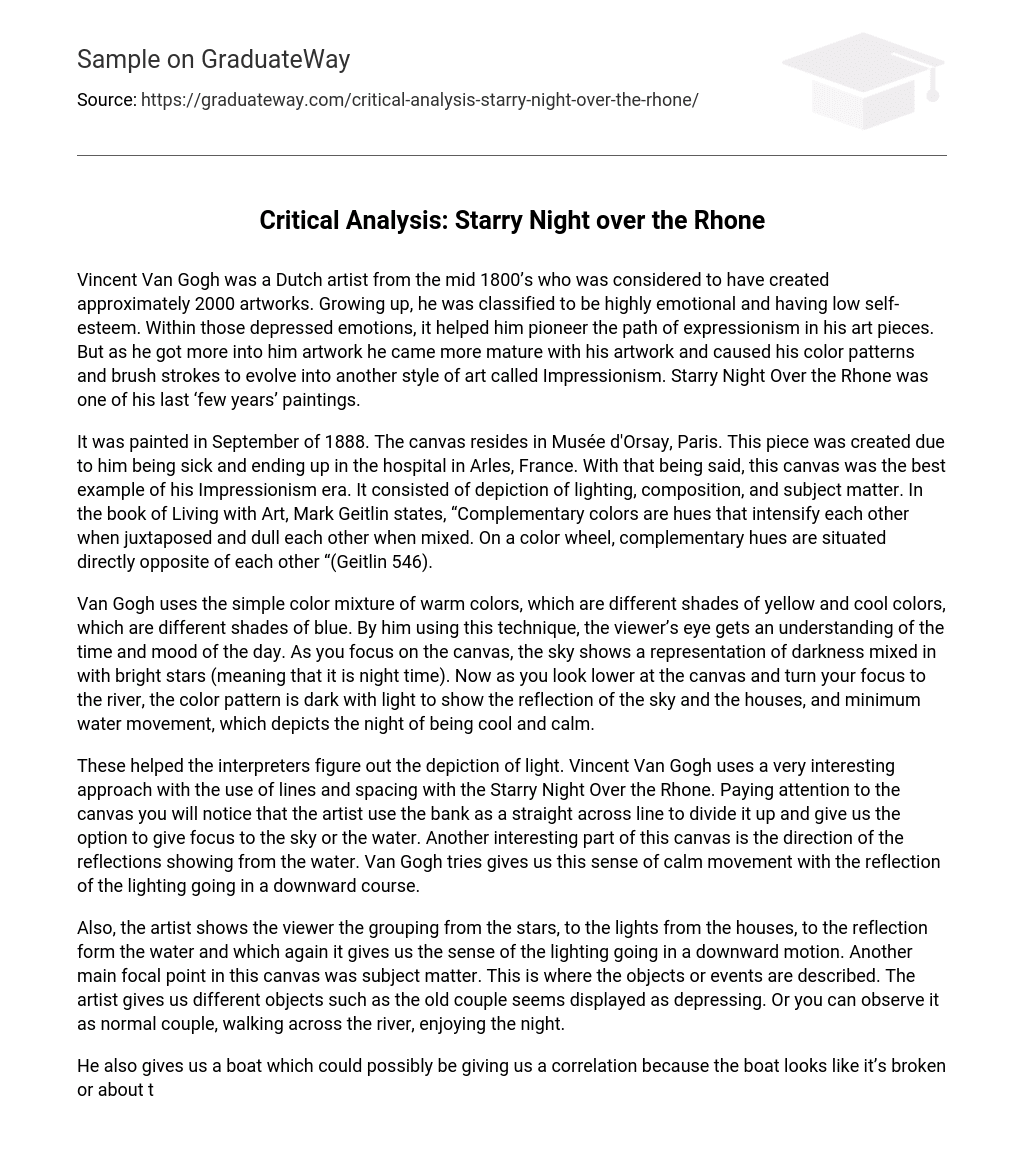Vincent Van Gogh was a Dutch artist from the mid 1800’s who was considered to have created approximately 2000 artworks. Growing up, he was classified to be highly emotional and having low self-esteem. Within those depressed emotions, it helped him pioneer the path of expressionism in his art pieces. But as he got more into him artwork he came more mature with his artwork and caused his color patterns and brush strokes to evolve into another style of art called Impressionism. Starry Night Over the Rhone was one of his last ‘few years’ paintings.
It was painted in September of 1888. The canvas resides in Musée d’Orsay, Paris. This piece was created due to him being sick and ending up in the hospital in Arles, France. With that being said, this canvas was the best example of his Impressionism era. It consisted of depiction of lighting, composition, and subject matter. In the book of Living with Art, Mark Geitlin states, “Complementary colors are hues that intensify each other when juxtaposed and dull each other when mixed. On a color wheel, complementary hues are situated directly opposite of each other “(Geitlin 546).
Van Gogh uses the simple color mixture of warm colors, which are different shades of yellow and cool colors, which are different shades of blue. By him using this technique, the viewer’s eye gets an understanding of the time and mood of the day. As you focus on the canvas, the sky shows a representation of darkness mixed in with bright stars (meaning that it is night time). Now as you look lower at the canvas and turn your focus to the river, the color pattern is dark with light to show the reflection of the sky and the houses, and minimum water movement, which depicts the night of being cool and calm.
These helped the interpreters figure out the depiction of light. Vincent Van Gogh uses a very interesting approach with the use of lines and spacing with the Starry Night Over the Rhone. Paying attention to the canvas you will notice that the artist use the bank as a straight across line to divide it up and give us the option to give focus to the sky or the water. Another interesting part of this canvas is the direction of the reflections showing from the water. Van Gogh tries gives us this sense of calm movement with the reflection of the lighting going in a downward course.
Also, the artist shows the viewer the grouping from the stars, to the lights from the houses, to the reflection form the water and which again it gives us the sense of the lighting going in a downward motion. Another main focal point in this canvas was subject matter. This is where the objects or events are described. The artist gives us different objects such as the old couple seems displayed as depressing. Or you can observe it as normal couple, walking across the river, enjoying the night.
He also gives us a boat which could possibly be giving us a correlation because the boat looks like it’s broken or about to sink. There is also another interpretation with the object that Van Gogh displays which is, the stars. Depending upon which way you want to take it, they look like flowers or fireworks. Also, there is a sense of false appearance with the houses. If you stare at just the bank you will notice that it is just a bunch of bright lights but if you pay attention to the water close to the bank, you will acknowledge the darkness or shadow of the houses.
What was the reason for Vincent Van Gogh creating the Starry Night Over the Rhone? Well, nobody will ever know because he is dead. But, for the viewers’ interpretation, you can idealize that he was just looking directly outside his window, wanting to show you the impression of a beautiful night. Another way you can take his work as, this canvas was the definition of him being at piece because as stated before, when he was younger he was classified as emotional and depressing. All in all, the piece that he created was amazing.
Whether it was looking at the sky, with all the shining stars or its looking at the river reflecting what’s going on in the sky or the river bank. It made you believe that you were actually in Paris looking across the river enjoying the scenery. Works Cited Getlein, Mark. Living with Art. 9th ed. Boston, MA: McGraw Hill, 2008. Print. “Starry Night Over the Rhone, Van Gogh. ” – Free Wallpapers. N. p. , n. d. Web. 23 Feb. 2013. “Vincent Van Gogh: Biography. ” Vincent Van Gogh Gallery. N. p. , n. d. Web. 23 Feb. 2013.





